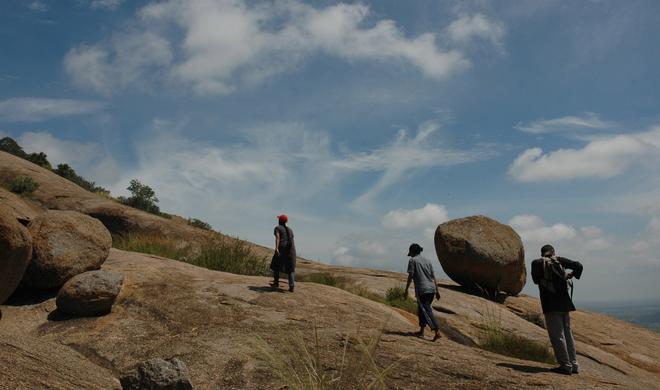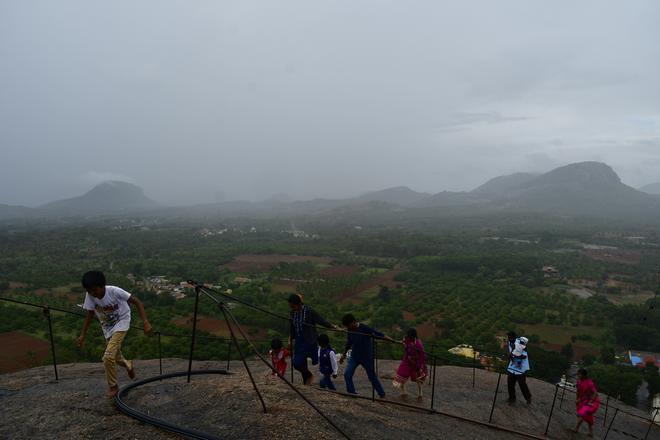On Republic Day, 954 trekkers who had tickets and over a thousand more who had shown up with the hope of getting tickets had gathered near the entry point of Kumara Parvatha. The fourth highest peak in Karnataka, at a height of 1,700 metres, it is situated in the ecologically fragile Pushpagiri Wildlife Sanctuary, whose entry point is in the Dakshina Kannada district in the Western Ghats. Videos of the overcrowding went viral; so did complaints of plastic bags, bottles, and leftover food that littered the forest.
The alarming number of people raised concerns about the threat posed by unregulated trekking across the State. With environmentalists raising concerns, the Environment Minister of Karnataka, Eshwar Khandre, imposed a temporary ban on trekking in Kumara Parvatha and other trekking paths in the State. He said they would be opened only after a standard operating procedure (SOP) is put in place.
Kumara Parvatha is managed by the Madikeri division of the Forest Department, with other trails like Kuduremukh being managed by their respective divisions. However the bulk of the trails — 23 trekking spots — fall under the Karnataka Ecotourism Development Board (KEDB), a wing of the Forest Department. As many as 1,13,243 people visited these between April and December 2023, bringing in a revenue of ₹3.73 crore. This is a significant increase from the entire previous financial year of April 2022 to March 2023, when there were 96,796 visitors (₹2.88 crore revenue). In 2021-22, when COVID-19 regulations were in place, 61,023 trekkers scaled the hills (₹1.45 crore).
Skandagiri in Chickballapur district, around 60 kilometres from Bengaluru, was the most popular trekking stretch with 45,018 visitors in 2023, bringing in ₹1.72 crore. This was followed by Makalidurga in Bengaluru Rural district, which had 15,454 visitors; Antharagange in Kolar district, which had 13,272 visitors; and Savandurga in Ramanagara district, with 8,069 visitors.

The way it works
Trekking paths must be booked online beforehand, and each has a limited number of slots per day (100 to 350). The online government portal — Karnatakaecotourism.com — is supposed to provide trekkers with guide services and first aid. However, regular trekkers have noticed that, except in a few places, on-ground regulation is poor.
“Except for Skandagiri and Makalidurga, forest guards are not available anywhere else even to check the head count. In the absence of guides, it is easy to get lost at some of these treks,” said Satyananda. M, a regular trekker who has covered most trails maintained by the KEDB. He adds that at the top of many hills, vendors sell soft drinks and instant noodles, and there is no waste management system. “If visitors are being charged for going down these trails, there must be regulation and accountability,” he said. Most regular trekkers praise the Kuduremukha National Park for its well-regulated, well-organised treks to three peaks in the area.
Officials are aware of the lax maintenance of rules at many trails. Kumar Pushkar, the Chief Executive Officer of KEDB, said guards on some trails were not as diligent, and there was scope for improvement. He also said the KEDB was actively trying to bring about stricter vigilance at all trekking points. Citing one such example, he said, “At Savandurga, I have now asked the Deputy Conservator of Forest (DCF) to completely fence the area and ensure that there is only one entry point to stop illegal entries. A guard will be posted to check the tickets.”
Ecological damage
The foremost concern about unregulated treks is the damage they cause to the biodiversity of the region. Capturing the concerns of nature enthusiasts and environmentalists, D.S.D. Solanki, who has been organising treks for 37 years, says, poetically, “Instead of leaving just their footprints, people only leave trash, mostly plastic, behind now.”
At the trails where guards are present, sometimes all the plastic is taken away before people start their treks. At some other places, they count the number of plastic items before and after the trek and fine violators if there is a discrepancy. On most trails that are well guarded, bags are tied to trees, like makeshift garbage bins to stop littering.
Pushkar said the key to avoiding littering also lies in bringing all the trek trails under the SOP. “When we send a guide with the trekkers if they try to litter, the guides will stop them from doing it,” he said. Solanki also raised the issue of human waste. “If thousands of people go up on a trail like Kumara Parvatha, and all of them attend to the nature’s call over there, then even that is a contributor to the ecological imbalance in the forest.”
Nagaraj Koove, an environmentalist and coordinator of the Biodiversity, Environment and Agriculture Study Centre (BEAS) in Sringeri, felt that uncontrolled trekking, while harming biodiversity, also affects the local public. “Trekking should be conducted in a way that the activity does not affect nature. If the number of visitors increases, roads will be developed. Such developments lead to landslides during heavy rains,” he said.
There is also the inconvenience to people living in the area. On weekends, with hundreds visiting Devaramane and Yettina Bhuja hills in Chikkamagaluru district and Kodachadri Hills in Shivamogga district, the roads leading to these locations get congested. With no restriction on the number of visitors per day, holiday seasons invariably result in traffic jams and parking hassles. “Committees involving local people should be constituted to monitor trekking. As it is the practice in northeastern States, local people should be given responsibilities,” he said.
Pushkar said locals are being trained near many trails to take on responsibilities as supervisors. KEDB is also planning to create washroom facilities and hire people to manage them.
Safety concerns
In December, Gagandeep Singh, a native of Uttar Pradesh who had been working in Bengaluru, went missing in Savandurga after being separated from his friend. Five days later, he was found dead by Forest Department officials. The hill is now temporarily closed for trekking. Such accidents have occurred several times in Savandurga, which is known to be dangerous due to its steep and slippery geographical features.
A 24-year-old techie from Chennai was part of a team that planned a trekking expedition in the Western Ghats near Sakaleshpur during the rains in July 2014. He was separated from the team and was lost in the forests for three days. On the fourth day, somehow, he reached the Hassan-Mangaluru highway to safety.
The Forest Department, which had no clue about the trekking expedition, booked a case against the trekkers under Section 24 of the Karnataka Forest Act, 1963, for entering the reserve forest without permission. There have been a few such incidents in parts of Hassan and Chikkamagaluru districts in recent years.
Mandalapatti in Kodagu district, nestled among picturesque hills, shot to fame after the hit Kannada film Galipata showed it as Mugilupete (translating to ‘town of clouds’). After a series of accidents in December, the local authorities banned the use of private vehicles to access the hill. Local resident Bopanna K.B. said numerous tourists who lack hill-driving skills are using their personal vehicles on roads intended only for SUVs, resulting in an increase in accidents.
The exact number of accidents that have happened on trekking trails is not available to government officials. However, Pushkar said most of these accidents during treks happen due to people climbing up the hills in an unregulated manner. He said the KEDB will look into locating the nearest hospitals or healthcare centres in case a medical emergency arises during a trek.

The rush to the top
Environmentalists express concern over the reason people trek. “Previously, those who were interested in nature and wildlife conservation, wildlife photography, and adventure used to go trekking. Now, people are going there for social media, to take selfies and videos there,” Solanki said, adding that homestays sometimes played loud music and had scant respect for the locals and wildlife. “Even trekkers who go up the hills play music on their Bluetooth speakers, ruining the experience for other interested trekkers,” he added.
Although many nature enthusiasts have called for a complete ban on trekking activities in forests, especially in the eco-sensitive Western Ghats, Minister Khandre said restricting nature lovers would be difficult. He said measures would be taken to ensure that no harm was done to the ecology due to trekking activities.
There is no clarity on when the SOPs will be formalised. With the next few months being the season for forest fires followed by the monsoon, the forest officials’ concerns remain to safeguard the forests while making safety provisions for trekkers. A new Eco Tourism Policy, announced by Khandre a few months ago, is also expected to come into being soon.
(With inputs from Sathish G.T and Darshan Devaiah B.P.)







